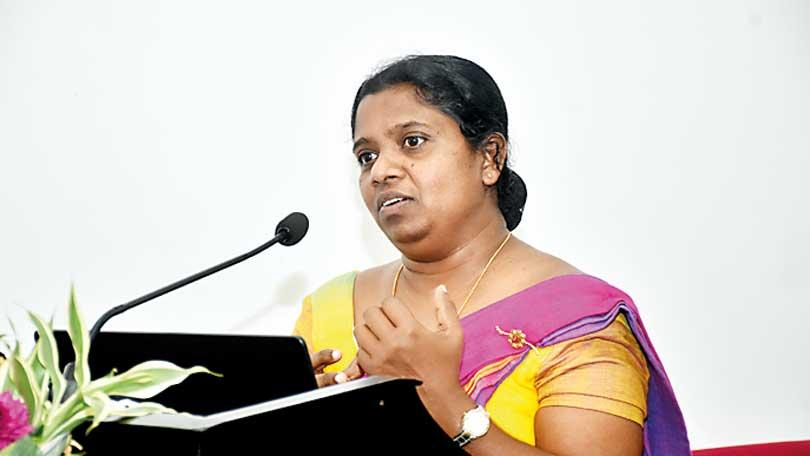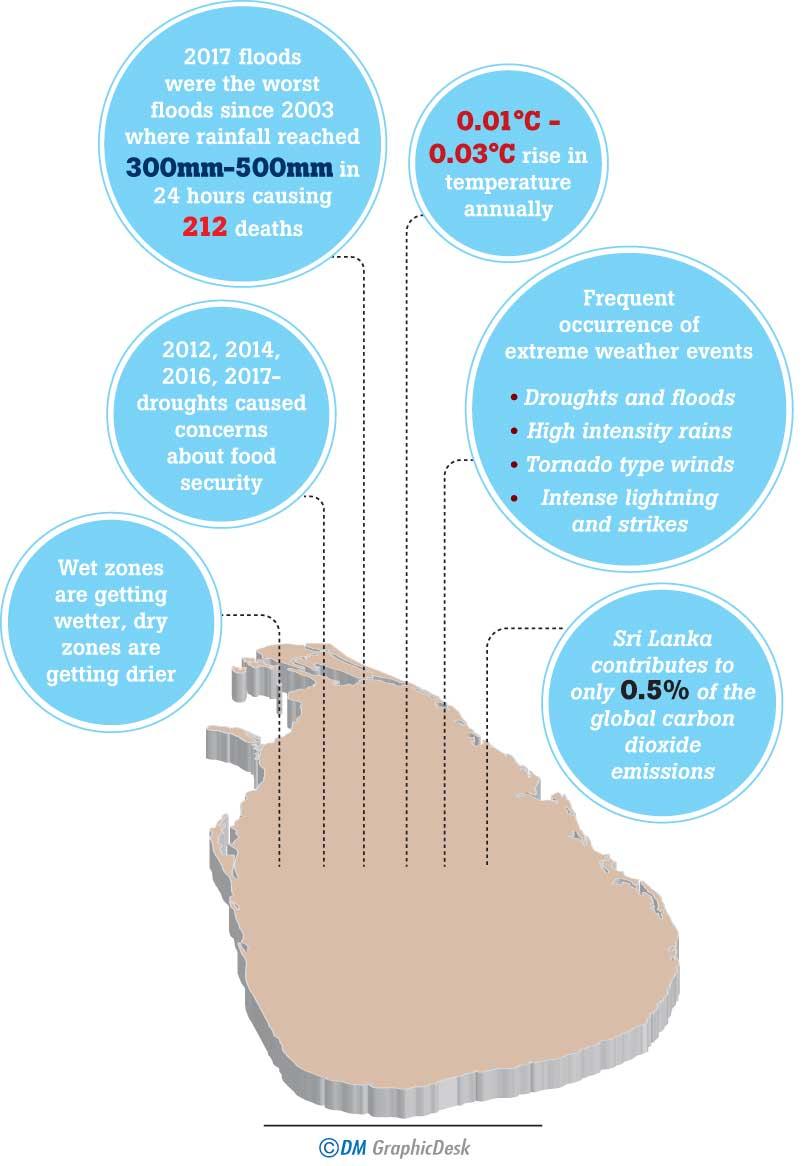Reply To:
Name - Reply Comment
Last Updated : 2024-04-20 00:00:00

 Landslides, floods, out of season monsoons and droughts have affected Sri Lanka in the recent past. If one was curious about the reason, there’s no doubt that these are effects of climate change. Sri Lanka was placed second in the Global Climate Risk Index, which means Sri Lanka is in a precarious position. In this backdrop, to increase awareness on climate change, the Climate Change Secretariat organised the ‘Sri Lanka Next- A Blue Green Era’ exhibition and conference at Bandaranaike Memorial International Conference Hall (BMICH) for the fourth consecutive year. A panel discussion was also held to educate the public on the national initiatives to minimize the effects of climate change.
Landslides, floods, out of season monsoons and droughts have affected Sri Lanka in the recent past. If one was curious about the reason, there’s no doubt that these are effects of climate change. Sri Lanka was placed second in the Global Climate Risk Index, which means Sri Lanka is in a precarious position. In this backdrop, to increase awareness on climate change, the Climate Change Secretariat organised the ‘Sri Lanka Next- A Blue Green Era’ exhibition and conference at Bandaranaike Memorial International Conference Hall (BMICH) for the fourth consecutive year. A panel discussion was also held to educate the public on the national initiatives to minimize the effects of climate change.
Dr. R.D. S. Jayathunga, Director of the Climate Change Secretariat stated that Sri Lanka is party to almost all global environmental agreements. “Though our contribution to global warming is negligible, we are adversely affected. We sign these agreements to help the global action on climate change,” he said.
He also noted that Sri Lanka’s stance on climate change was one of adaptation and increasing resilience, Many projects such as the Climate Resilience Improvement Project (CRIP), Climate Smart Agriculture Project, Climate Resilience Multi- Phase Programmatic Approach project are being carried out to increase resilience.
Dry areas are going to be drier and wet areas are going to be wetter. Both are going towards two extremes
Speaking at the panel discussion, Prof. Buddhi Marambe, Chairman of the National Experts Committee on Climate Change Adaptation (NECCCA) stated that one of the detrimental effects of climate change is the impact on crop harvests and food security. He referred to Prof. Punyawardena’s 2010 study on climate change patterns in Sri Lanka. “The dry areas are going to be drier and the wet areas are going to be wetter. Both are going towards two extremes and our food security is threatened. We are going from bad to worse,” he informed.
He also revealed that Sri Lankans need 196 000 MT of rice per month for consumption and there would be a need for rice imports if no action is taken to ensure food security. He predicted that in the next 3 decades, Sri Lanka’s agricultural productivity will reduce by 10%. He also revealed that the crop loss during the Yala and Maha seasons from 2015- 2017 had compelled the country to import rice. He revealed that 300 0000 ha of paddy was destroyed in the 2012 drought and in 2014- the 11 month drought reduced agriculture production to 40% and 30% of crop losses was reported from Northern Province. He mentioned there was a 4.9% growth in the agriculture industry in 2018.
He also stated that the ‘Overarching Agriculture Policy’ developed with the assistance of the European Union (EU) can help to solve these issues. “We need proper policies in place to be able to take effective action in protecting our food security,” he said. He noted that Sri Lanka had identified food sector as a vulnerable sector in climate change. Due to which, the 2016 National Adaptation Plan (NAP) has policies and actions geared towards increasing food security which include cultivation of climate resilient crops.
All development programmes and novel technologies should minimize impacts of climate change
Development was found to be the main cause for environmental issues and climate change. However, development cannot be compromised due to environmental impacts opined Buddhika Hemashantha, Member of NECCC- Mitigation. “All the development programmes and novel technologies should minimize impacts of climate change and foster sustainable development,” he stated. He also opined that international agreements like the Kyoto Protocol and the Paris Agreement, both of which Sri Lanka has ratified, are good initiatives that have united countries in their efforts to minimize climate change impacts.
“The Kyoto Protocol’s climate target was to limit global temperature increase to 2°C but it was later found out that irreversible impacts could occur even by a rise of 0.5°C. This could lead to 30% land area in Bangladesh to be under water,” he explained.
The same target was repeated in the Paris Agreement. Hemashantha revealed that to reach that target, 25% of the global emissions should be reduced within the next 10 years. He stated that Sri Lanka’s carbon dioxide (CO2 ) emissions was 28 million tonnes and only made up for 0.5% of the global CO2 emissions. “CO2 contributes to 70% of the green house gas (GHG) emissions and this causes global warming,” he said. For the Paris Agreement, Sri Lanka has pledged to reduce GHG emissions against Business- As- Usual (BAU) scenario by 20% in energy sector (4% unconditionally and 16% conditionally) and by 10% in other sectors (transport, industry, forests and waste) by 3% unconditionally and 7% conditionally by 2030. “The reductions that are done unconditionally is without any international technical or financial support and conditional reductions are done with international technical and/or financial support,” he explained.
Mr. Hemashantha also stated that if the projects are implemented effectively, then emissions can be reduced up to 30% and Sri Lanka would be able to meet the targets set in the Paris Agreement. He opined that governments would be hesitant to implement eco friendly initiatives because those options are expensive and would lead to an increase in the cost of living. “In Germany and China, people pressurized the governments to decommission coal and implement eco friendly projects that foster sustainability. The governments had to take such actions because of the pressure from the people. If people pressurize the government, then there is a high probability the government will implement eco friendly projects,” he claimed.

I urge policy makers to incorporate DMC’s guidelines in their policies
Dr. Sirohmani Jayawardena, Deputy Directress, Meteorology Department, defined climate change as the “state of the climate that can be identified by changes in the mean and/or the variability of its properties.” She explained that the global climate depends on the amount of energy received by the Sun and the amount of energy trapped in the system. She also stated that climate variability and climate change are different. “Climate variability consists of short term fluctuations but natural climate variability consists of fluctuations throughout a longer time scale like seasons and years whilst climate change persists for an extended period like decades or longer,” she delineated.
She stated that to mitigate risks of climate change, it was imperative to make accurate climatic projections and revealed that climate models were used to do that. “Climatic predictions and projections are different. Projection is how the climate system will change in response to changing boundary conditions. Prediction is the short term evolution of the climate system from the initial state under constant boundary conditions,” she stated. Examples of boundary conditions are intensity of solar radiation and composition of the atmosphere. Climate models are systems of differential equations based on the basic laws of physics and chemistry.
The global climate change projections are based on 100km climate model simulations.
Climate model results provide the basis for future climate change projections but results can be inaccurate due to uncertain GHG emissions scenarios, uncertain estimates of population growth, changes in land use and economic growth. She stated that developments are underway to overcome these inaccuracies to improve global forecasts.
Speaking about disaster risk reduction and management, Ms. Anoja Senevirathna, Director of Mitigation Research and Development Division of the Disaster Management Center (DMC) stated that there are effective disaster management systems in place like the Flash Flood Guidance system, Drought Monitoring system, Drought Early Warning system and Lightning Detection system.
She informed that there were many policies in place to effectively manage and reduce impacts of disasters yet they cannot be properly implemented due to various gaps and constraints.
Gaps
“Currently we are preparing national strategies for disaster risk management but I urge policy makers to incorporate DMC’s guidelines in their policies,” she stated. She also opined that unsustainable development projects result in increasing the negative impacts of climate change. She also added that the DMC had developed spatial data which can be accessed by the public online, end of year risk index reports at Grama Sevaka level and an emergency hotline for the public to call in the event of a disaster.
By being aware of climate change, it would be easier to minimize the negative impacts on climate change
Climate change can cause numerous disasters and Ms. Voshita Wijenayake, CEO of SLYCAN Trust, said that there was need for collective action to minimize the adverse effects of climate change. “People should be encouraged to take action, people should have hope that they can do something. This has to be promulgated by us to the others. It’s our duty,” she urged.
She stressed on the importance of the media’s role on educating people on climate change and encouraging collective action. She described on how to encourage people to take action. “Focus on issues that are of importance to the person or audience. But before that, we must understand their beliefs, geopolitical environment and interests. We can’t just tell people to do something just because we want them to.” She also suggested being well- informed of environmental issues prior to encouraging and motivating people. Ms. Wijenayake further stated that to minimize climate change impacts, the policy makers, government, civil society organizations, youth organizations, schools and individuals will have to work collectively whilst motivating and encouraging each other.
“By being aware of climate change, it would be easier to minimize the negative impacts on climate change. Because we will take conscious environmental friendly decisions individually, and by all of us doing so, it would create a impactful effect,” she concluded.


Add comment
Comments will be edited (grammar, spelling and slang) and authorized at the discretion of Daily Mirror online. The website also has the right not to publish selected comments.
Reply To:
Name - Reply Comment
On March 26, a couple arriving from Thailand was arrested with 88 live animal
According to villagers from Naula-Moragolla out of 105 families 80 can afford
Is the situation in Sri Lanka so grim that locals harbour hope that they coul
A recent post on social media revealed that three purple-faced langurs near t